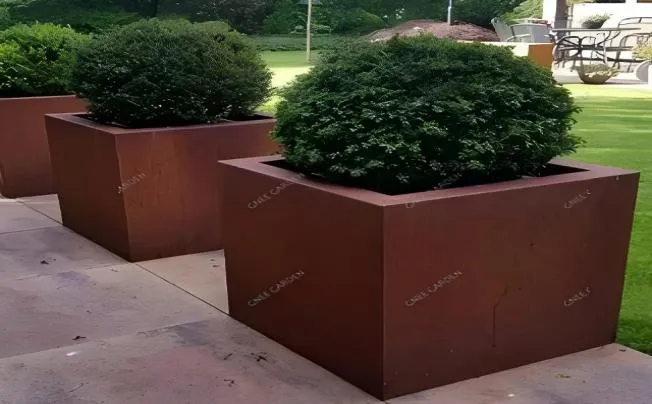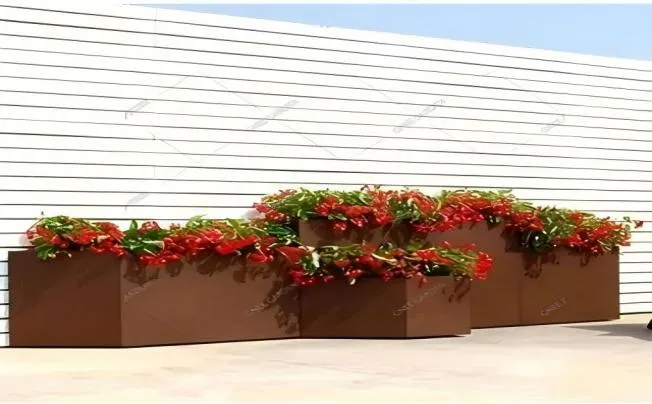How Do You Know If A Plant Pot Is Too Big?
Flower pots serve as the "home" of plants, and the growth of the plants is strongly correlated with the size of the pot.
Intuitive signs of a flowerpot being too large
There is an imbalance in the proportions between the plant and the flowerpot
The first thing that comes to mind when you see a pot of plants is how well the plants and the flowerpot match. The plant will look especially tiny and alone in a flowerpot that is too big. For instance, when little, beautiful succulent plants are paired with large flowerpots, the result is a visually abrupt arrangement that utterly destroys the succulents' inherent attractiveness. Furthermore, this imbalance has an impact on plant growth in addition to being an aesthetic issue. Plants in oversized flowerpots will grow slowly and take longer to exhibit vigorous vitality because their roots will be too widely spaced during the early growth stage, using too much energy to "explore" the soil and unable to focus on moving nutrients upward.
After watering, the pot soil is unevenly wet and dry
If the pot is too big, the soil on the outside will dry up soon after watering, turning white and cracking. However, if you dig a little deeper with your hands or tools, you'll be shocked to discover that the soil in the centre and lower sections is still wet. The reason for this is that the pot is too big, the water loss is mostly focused on the soil's top, and it is hard for the water in the middle and lower sections to evaporate rapidly. When it comes to watering, this inconsistent wetness and dryness can seriously mislead you, leading you to feel that the soil is deficient in water and that regular watering is necessary. Long-term water buildup at the flowerpot's bottom causes the plant roots to become soaked in the "water prison" for an extended period of time, suffocating from a lack of oxygen and eventually decaying. Additionally, there is a dramatic decline in the overall health of the plant.

Judging from the growth status of plants
Unusual development of roots
An too large flowerpot can cause excessive root development and entanglement, as well as block the drainage holes at the bottom, as the plant roots grow wantonly in the large soil space. It is not good that there is so much growth. In the flowerpot, the roots keep growing, using a lot of nutrients for their own growth while neglecting the upward flow of nutrients to the branches and leaves. Additionally, the entangled roots will impede the soil's air movement, depriving the roots of oxygen and impairing the plant's ability to grow normally. The plant will eventually exhibit issues like sluggishness, limited development, and few or no flowers.
Branch and leaf development that is sluggish or slow
There are two extremes in the growth of branches and leaves when the flowerpot is too big. On the one hand, the "energy" supplied to the branches and leaves is insufficient due to the roots' inability to efficiently absorb nutrients in the loose soil of the large flowerpot. This causes the branches and leaves to grow slowly, few new leaves to sprout, the leaves to be small and yellow, and the entire plant to appear lifeless. However, some plants will become overly long. This is because the big flower pots provide the roots a fair amount of room. They grow frantically when there is an abundance of water and nitrogen fertilizer, but they disregard the thick leaves and branches. In addition to reducing the plant's aesthetic appeal, the long, weak branches and leaves with lengthened internodes also make it more susceptible to disease and insect infestations. It is unable to sustain its own "weight" and could tumble to the ground in a breeze.

Practical tips and advice
1. Examine the size of the plant's roots and crown
Choosing a flower container based on the size of the plant's root and crown is an easy and useful way for novices. In general, the flower pot's diameter is between one-third and half of the plant's crown. For instance, selecting a flower container with a diameter of 10 to 15 cm can typically satisfy the plant's initial development requirements after its crown reaches 30 cm. Simultaneously, it is crucial to monitor the state of the plant's root system. While flowers with slender and short roots, like annual herbaceous flowers, should not use too large flower pots to prevent the roots from "losing their way" in loose soil and affecting nutrient absorption, the size of the flower pot can be appropriately increased if the root system is well-developed and strong, like some woody flowers.
2. The method of gradual repotting
Repotting is an essential element of flower growth, but it's better to avoid replacing too big of a pot all at once. The gradual replacement of the flower pot is a more dependable method. For instance, flowers are initially kept in a tiny container that is around 10 cm in diameter when they are still seedlings. They are changed with pots that are 15 to 20 cm in diameter once the plants have grown for a while and the roots have started to fill the pots and the growth pace has slowed. In order to prevent issues like root growth disorder and plant growth stagnation brought on by an abrupt "move" to a large pot, the roots are given time to adjust to the new soil environment and growth space. This ensures that the flowers are given the proper care at every stage of their development.

Selected Blogs
-
What customization services are available for metalworking customization?
2024-12-12
-
What Is The Difference Between A Plant Container And A Raised Bed?
2024-04-23
-
Garden Screening & Fence Panels
2024-04-23
-
Gardening pot selection tips
2024-04-17
-
The function and collocation of horticultural fire pot
2024-04-17


